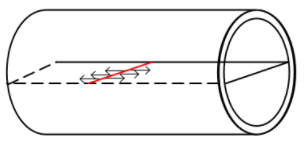Question
Easy
Solving time: 2 mins
A uniform vertical tube of circular cross section contains a liquid. The contact angle is 90°. Consider a diameter of the tube lying in the surface of the liquid. The surface to the right of this diameter pulls the surface on the left of it. What keeps the surface on the left in equilibrium?
Found 8 tutors discussing this question
Discuss this question LIVE
11 mins ago
 Text solution
Text solution Verified
Verified
As the angle of contact is 0, there is no force between the surface of the tube and the liquid. The diameter of the liquid surface is pulled on both sides by equal and opposite forces of surface tension. This results in no net force remaining on the surface of the liquid. Hence, the liquid stays in equilibrium.

Was this solution helpful?
98
Share
Report

One destination to cover all your homework and assignment needs
Learn Practice Revision Succeed

Instant 1:1 help, 24x7
60, 000+ Expert tutors

Textbook solutions
Big idea maths, McGraw-Hill Education etc

Essay review
Get expert feedback on your essay

Schedule classes
High dosage tutoring from Dedicated 3 experts
Practice questions from Concepts of Physics (HC Verma Part I)
Question 1
Medium
Views: 6,131
Question 2
Easy
Views: 6,201
Question 3
Easy
Views: 6,285
Practice more questions from Mechanical Properties of Solids
Question 1
Medium
Views: 5,701
[Density of sea water ]
Question 2
Medium
Views: 5,231
Question 3
Hard
Views: 5,943
Question 4
Hard
Views: 5,519
Practice questions on similar concepts asked by Filo students
Question 1
Views: 5,584
Question 2
Views: 5,188
Question 4
Views: 5,229


Stuck on the question or explanation?
Connect with our Physics tutors online and get step by step solution of this question.
231 students are taking LIVE classes
| Question Text | A uniform vertical tube of circular cross section contains a liquid. The contact angle is 90°. Consider a diameter of the tube lying in the surface of the liquid. The surface to the right of this diameter pulls the surface on the left of it. What keeps the surface on the left in equilibrium? |
| Updated On | Feb 1, 2022 |
| Topic | Mechanical Properties of Solids |
| Subject | Physics |
| Class | Class 11 |
| Answer Type | Text solution:1 Video solution: 1 |
| Upvotes | 200 |
| Avg. Video Duration | 8 min |



